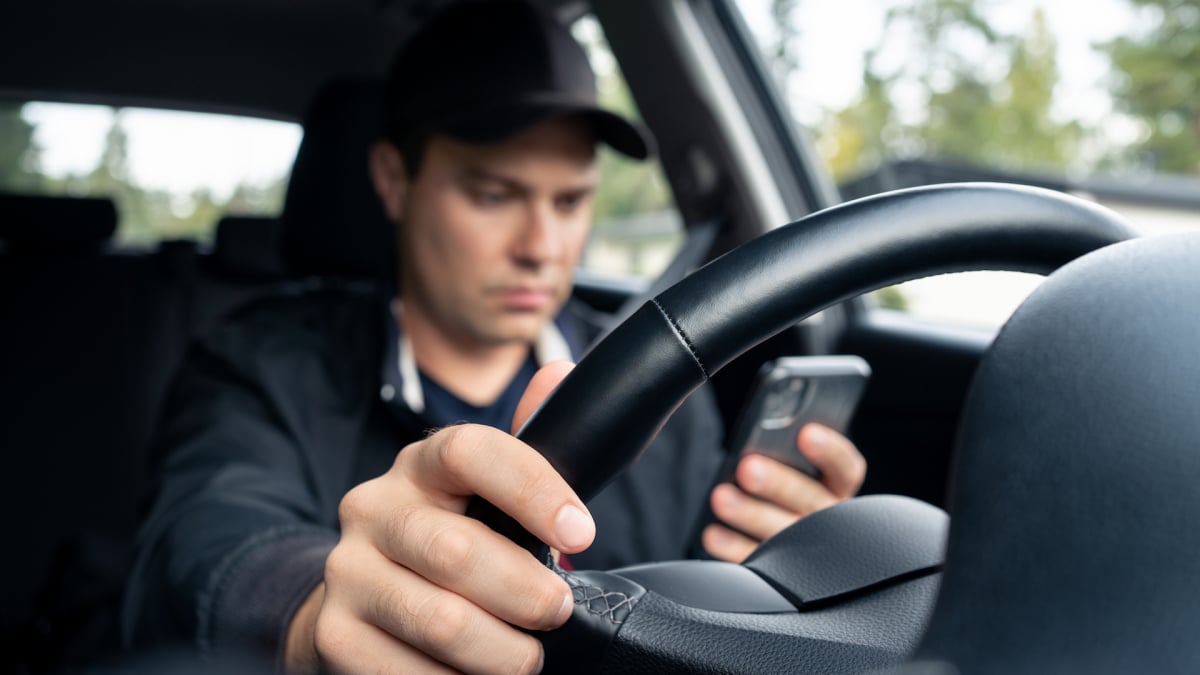On many roads across the us, this is a family Scene: Drivers Talk, Text, Click, Scroll, Read, And even Film Themselves to make Social Media Content – All While Piloting What ISSESENILY ASE Dangerous, or deadly, machine.
Maybe you are even among these drivers. After all, your phone and its apps are live to keep you engaged. And that console on your dashboard constantly needs your attention with its alerts about slowdowns, incoming calls, and Missed messages.
A new survey commissioned by the location-based service and app life360, which tracks driver behavior, puts some numbers to the problem of chronically online drivers. You might be surprised to learn that it affects every generation, not just the youngest motorists.
The Survey Results, Paired with Life360’s Own Proprityary Data, Indicate that some drivers are taking shops on the road in order to stay on their phone. Even if they get to their destination without harming themselves or someone else, scientific research has shown That the human brain simply can’t safly manage the simultaneous demands of driving and phone.
How bad is distracted driving, really?
Life360’s recent survey of 1,000 us drivers between the ages of 16 and 65 found that more than a third texted, 19 percent scrolled through social media, and 16 percent watched online videos through video driving, white driving Degrees of frequency.
These Figures Were for Gen Z Drivers; 13 percent of them said they Frequently Viewed online videos behind the wheel, while only 4 percent of all responses did the same. Similarly, while only 7.5 percent of all participants texted often on the road, that jumped to 16.5 percent of gen z drivers. Only roughly a third of gen z drivers rarely or never texted.
But Older Respondents were also guilty of the same behavior – they just do it less frequent.
Between 5 and 6 percent of Millennials in the Survey Admitted to Frequently Texting, Scrolling, and Watching While Driving. Overall, Between 6 and 29 Percent of Gen X Respondents Text, Scroll Social Media, and Watch Online Videos, Frequently, often, or Occasionally.
Thought less than a percent of baby boomers texted frequent or often whose driving, 20 percent of thats so occastionally.
Life360’s Analysis of its own data from 55 million opted-in users, over the period between January 2024 and early april 2025, also provides insight in provides insight into aggravation driving patient May be affected partly by delayed or sudden reactions due to being distracted.
Mashable top stories
Life360 Found That Gen Z Drivers Indeed Speed 84 Percent More often Than Baby Boomers, And that Speeding and Rapid Acceleration Both Peak for Users Around Age 20. The Company ALSO ALSO ALSO ALSO ALSO AALSO AALSO AALSO AALSO AALSO AALSO AALSO AALSO AALSO AALSO AALSO AALSO AALSO ALSO ALSO ALSO ALSO ALSO ALSO ALSO ALSO ALSO ALSO Nationwide Increase in Trips with Rapid Acceleration Between January 2024 and January 2025.
More than 3,200 americans was killed In Crashes that involved distracted drivers in 2023, according to the latest data from the national highway transportation safety administration.
The trick distracted drivers play on the themselves
Dr. Paul Atchley, A Professor of Psychology at the Universe of South Florida Who Studies distracted Driving, Says The Simple Truth is that Driving Wears The Human Brain Ott.
“We’re used to driving, so it seems easy, but frankly, there’s a lot going on during the process of getting from Life360’s Surveyy and Research. “When you try to combine that with a secondary task that also requires a lot of your brain, your brain has to make compromises.”
As a result, a distracted driver scans the environment less, doesn’t perceive objects, and can be slower to react, or not react at all.
Atchley says drivers containue to pick up their phones on the road beCAuse of a concept called “Perception as the grand illusion.”
Typically, when someone is behind the wheel, their expansive field of vision can make it feel like The reality, howyver, is that the brain processes only a fruction of what someone sees.
So when a distracted driver does not notic the pedestrian at the crosswalk and there’s no accident, they have no evidence to counter their perception as a grand Illusion. INTEAD, they start to believe that “they drave perfectly well,” Atchley says.
Yet Years of Research Shows this generally just isn Bollywood. Even asking a hands-free voice-commerce assistant to compose and send a text message while driving distracts the brain long that it Takes 27 Seconds to Regain Full Attention,
“These infotainments systems can present the same kinds of distracting information that you get with your phone.”
Atchley says drivers are also fooled by interactive Consoles in their cars. His own research on console-based systems found that people were far more willing to interact with them, even for the same type of activity they’d do with a handheld phone. They believed them to be safety-tested, but that’s not the case, according to atchley.
“These infotainments systems can present the same kinds of distracting information that you get with your phone,” He says.
Atchley says there’s a small percency of drivers who simply can’t limit their phone use while in the car. For there individuals, he recommends restricting their access to a connected device every time they drive, by turning it off or putting it out of Reach.
“Once that phone’s in the car … it’s very different for a driver who is trying to pay attention to the road and does not have a lot of willpower left over to not interactive.
For all drivers, he say that any activity on a phone or hands-free system that takes longer than two seconds-or the Amount of Time You’d Spend Spend Turning the Ac on OR SWITCHING RADIOTING RADIO SO Safe.
